Download this chapter for offline viewing (no videos, 3MB)
Download this chapter for offline viewing (includes video content, 29MB)
All mass share a common distance moving away from and curved around the Big Bang center. In keeping with General Relativity this curvature acts as a central gravitational force that determines the Universe’s radius. This curvature extreme is the universal present and the event horizon of the Universal Black Hole. The Universe’s mass and mass density are a product of the Universe’s black hole structure.
What Is Mass?
We experience the substance of stuff as part of everything that we do. Movement itself requires the measuring of that substance. We push ourselves out of a chair and depending upon our weight, we apply the force necessary to raise ourselves against the gravitational bound with the Earth. We are experiencing mass in the context of its proximity to a massive object – the Earth. We refer to this as weight.
Weight is dependent upon the mass of the attracting body. When Neil Armstrong and Buzz Aldrin stepped on the moon, they weighed 1/6 of what their weight would be on Earth. A 200 pound man would weigh approximately 33 pounds on the moon. So even though these two individuals were the same as they would have been donning the identical equipment on Earth, their weight was vastly different when proximate to the moon instead of the Earth.
What was unchanged was their mass. While weight is dependent upon gravitational acceleration, mass is not. Galileo and later Isaac Newton contributed to the determination that mass is the relative resistance to acceleration by a force. The more massive the object is, the greater the force necessary to change its direction and rate of motion.
This resistance is referred to as inertia. A body at rest will tend to stay at rest, and a body in motion will tend to stay in motion. An aspect of inertia is that objects not only resist the change in the rate of motion, they also resist the change in the direction of that motion. Both changes require acceleration by a force. Since direction of motion is embedded in the inertia of an object, inertia is a vector-sum dependent aspect of a mass.
Mass is the containment of free energy. Energy of movement becomes particles. Energy has no rest mass, but it does have a mass equivalent through the velocity of light’s conversion in mc2. Mass is the containment of free energy. This is done through the electromagnetic force, the strong force and the weak force.
Energy contained in localized space resists change of position. Another phenomenon in physics illustrates this. Angular momentum is the characteristic that causes a mass to resist change in motion. A gyroscope will maintain its rotational orientation. It can be moved around, but its rotational angle will resist change. Angular momentum creates a resistance in one of the three spatial dimensions.
Mass resists change in motion. It takes acceleration to change motion in all directions. Subatomic particles have quantum mechanical properties that are probabilistic in nature. Probable motion is in all directions at once. Probabilistic motion in all directions contained locally by the three forces creates mass.
Matter and the Standard Model
Typically we refer to mass when it’s in the form of matter. Matter is formed by subatomic particles bound together by the strong, weak and electromagnetic forces.
Hadrons are the dominant form of matter. They are made up of subatomic particles called quarks which are bound together by the strong force. There are two forms of hadrons – baryons and mesons. The baryons which are made up of three quarks that combine to form stable protons and neutrons that are the basis of the nucleus of the atom. Mesons are unstable forms of matter composed of a quark and an anti-quark. They are usually found as short-lived particles in the midst of decaying from high-energy collisions.
Another component of matter is the lepton. Leptons are not composed of quarks and are not bound by the strong force. Leptons are also fermions and carry the required 1/2 integer spin. Charged fermions are dominated by the electron but also include the muon and the requisite anti-particles.
Leptons include the existence of the elusive neutrinos, which have no charge. Neutrinos are composed of three flavors that randomly interchange. These are the electron, muon and tau neutrinos. Neutrinos are products of many decay processes guided by the weak nuclear force.
Another class of particles are bosons. Bosons have whole integer spins. They can coexist in the same quantum state with another particle. For this reason bosons are the carrier of force. These gauge bosons include light’s photon, which is a boson and is also the carrier of the electromagnetic force. The unseen gluon is the carrier of the strong force that binds quarks. The weak force mediates decay process by the W and the Z bosons.
The most intriguing boson is the Higgs boson. First postulated in the early 1960s to fill a hole in the “Standard Model” symmetry, the Higgs particle became a primary target for particle physicists. The Higgs boson is credited with being the carrier of mass for matter.
On December 15, 2015 an extremely short-lived particle with a decay pattern matching that predicted for the Higgs boson was observed at the CERN’s Large Hadron Collider. It is believed that this is the successful conclusion to the long sought after Higgs particle.
Together the electron leptons are bound with the proton/neutron nucleus by the electromagnetic force forming the atom. The atoms combine through weaker electric interactions to form the compounds that make up complex matter forms.
Mass & Energy Equivalence
Albert Einstein stated that mass and energy are equivalent. This equivalence is mediated by the square of the velocity of light in the formula E=mc2 Due to the extremely high conversion factor of c2 the amount of energy stored in matter is prodigious.
Free energy thus has mass. A hot dwarf star is more massive than a dwarf with the same amount of matter that has cooled over time.
So we have added energy to matter as a source of mass even though it is a mass-equivalent rather than a rest mass as is the case for matter. However, its proportion of the Universe’s free energy is quite small relative to that of matter.
Three-Dimensional Nature of Matter
Baryonic matter is composed of fermions. The nature of the 1/2 spins of fermions has great implications for the structure of matter. Wolfgang Pauli in 1925 developed the Pauli Exclusion Principle which states that no two fermions can occupy the same quantum state.
The quantum structure of the atom creates volume. Louis de Broglie determined in 1925 that matter traveled in wave forms thus sharing light’s particle-wave duality. Electrons orbit atomic nuclei as electron waveforms. These waveforms are not like planetary systems that tend to orbit along a specific orbital plane. Electrons are more a probability cloud around the nucleus.
Electrons are less massive than proton and neutron nucleons and therefore move in longer waveforms. The proton is 1,836 times as massive as the electron. Wavelengths for matter are inversely related to the mass of the particle. Therefore, the wavelength of electrons is 1,836 times that of a proton. It is for this reason that the electron shells are quite distant from the atomic nuclei.
Matter and Mass Density
Gas – Matter occupies volume. When matter is in the form of a dissociated gas, the volume in which the gas is confined determines particle speed. The mass of the gas particles and the average kinetic energy determine the temperature of the gas. The greater the number of particles and the smaller the confinement, the higher the temperature. It is the pressure provided by particle collisions that resist further confinement.
Liquids & Solids – When matter is sufficiently cool or when pressurized beyond a certain minimum, electrical attraction will cause the material to form a liquid or solid. The volume of the material is dependent upon particle size and the resistance to compression provided by the mutually repulsive electron shells. The electromagnetic force both binds matter into complex states and limits the volume of that binding.
Both states greatly increase the resistance to compression that exists for the gaseous states of matter. Atoms are in close contact for liquid states, but they are not typically organized in a rigid configuration. For solids, atomic structure dominates. Atoms tend to be rigidly aligned. They tend to vibrate within their localized position. The most organized states are often crystalline where the pattern of the structures within are repetitive and persistent throughout.
Metals have some of the characteristics of crystals but typically are more malleable. They tend to have free electrons that can be shared with adjacent atoms making them good conductors. These dissociated electrons have the characteristic of degeneracy, i.e., they no longer are contained in the orbits around the atomic nuclei.
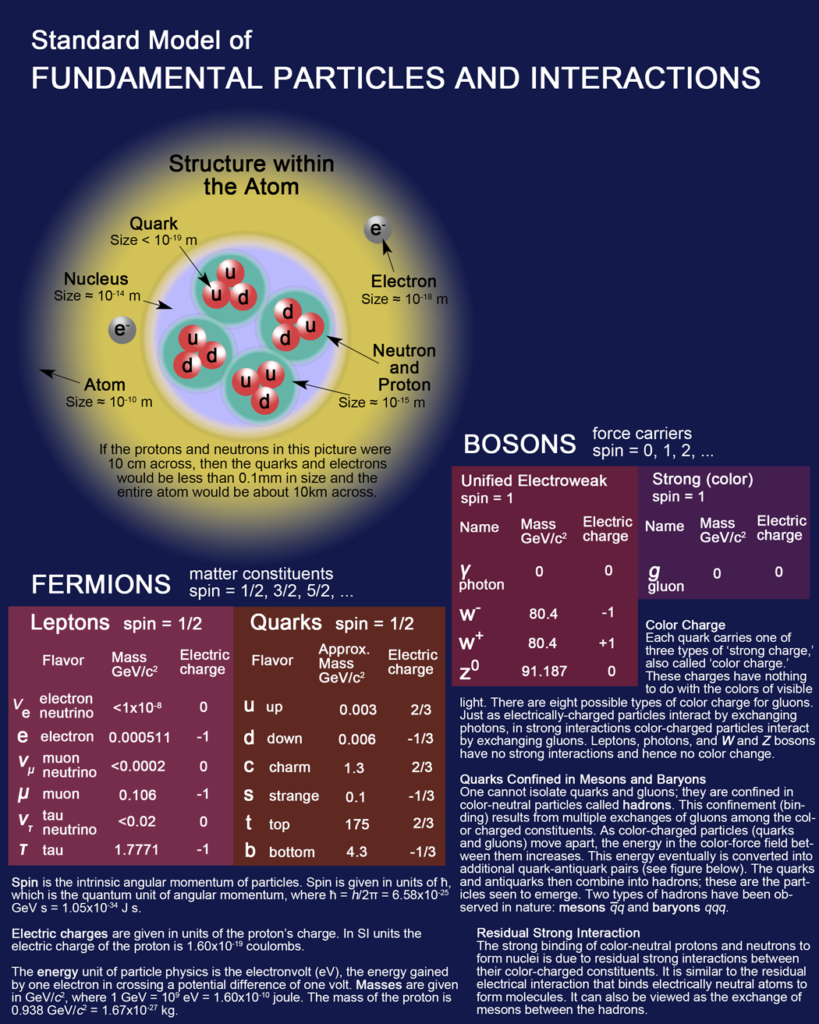
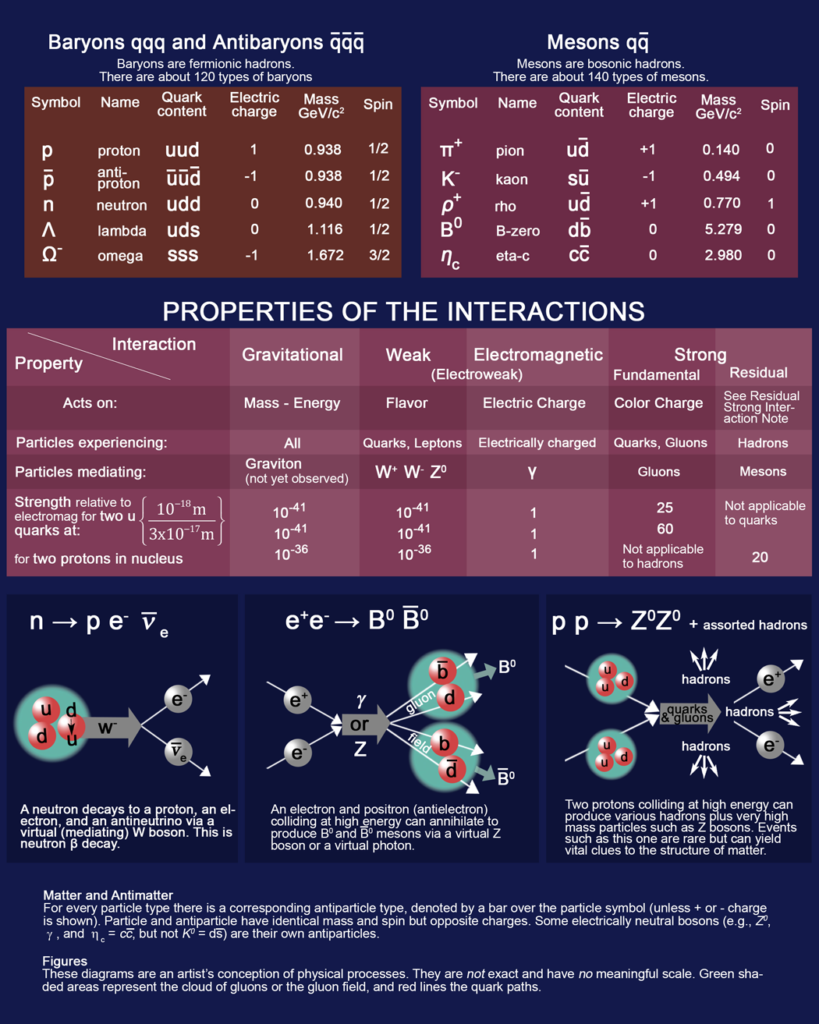
Degenerate Matter
When matter is compressed and heated as in the case of stars, it eventually forms a plasma. Plasma forms when heat of electrical ionization causes the electrons to dissociate from the atomic nuclei. The resulting dissociated form has some of the characteristics of a gas except it tends to be a good conductor of electricity and magnetic fields. Like a gas, plasma can be compressed. This occurs in stars.
Compression increases the thermal energy of the plasma. Electrons and protons are forced closer to each other. This results in higher velocity collisions within the plasma gas producing greater resistance to compression. As pressure builds, eventually thermal resistance fails to counter the increased compressive forces.
Enter quantum mechanics. Matter consists predominantly of fermions. Wolfgang Pauli in 1925 established his exclusion principle, which states that no two identical fermions can occupy the same quantum state simultaneously. The four quantum numbers (n, the principle quantum number, the angular momentum quantum number, m1, the magnetic quantum number, and ms, the spin quantum number) must be unique to every fermion particle. The 1/2 integer spins, i.e., 1/2, 3/2, 5/2, etc. identifies a particle as a fermion. Two fermions locally enclosed are always in an antisymmetrical state. They cannot fall into the same harmonic waveform.
For example, two electrons can assume the same orbital shell in an atom, but those two must have opposite spins, i.e., one +1/2 and the other -1/2. For a plasma, energy shells do not exist as in a neutral atom, but nevertheless no two quantum states can be duplicated.
Matter vigorously resists compression due to the Pauli exclusion. Even without any heat as would be in a black dwarf, i.e., a white dwarf that lost all of its thermal energy, matter will maintain its space.
A white dwarf, as will be the Sun’s fate, is a classic example of complete electron degeneracy. Degenerate matter is often referred to as a degenerate gas or Fermi gas. The density of white dwarf material is so great that a teaspoon would have a mass of 15 tons.1
The stellar remnants of a more massive star would be a neutron star (1.39Mʘ to 3Mʘ). The neutron star is an example of neutron-degenerate matter. It forms as a result of a supernova that compresses matter to the point where the electrons and the protons combine and form a large neutron nucleus. Degenerate neutrons are much denser than the electron-degeneracy produced in a white dwarf. Recent estimates of that density is that a teaspoon of the center of a neutron star’s material would have a mass of 4 billion tons (1017 kg/m3).
Theory states that a stellar remnant that is just short of that necessary to generate a black hole would produce a quark star either within the envelope of a neutron star or as a replacement of the neutron star. A quark star would be a repository of neutrons broken down into their fundamental components. A neutron is composed of an “up” quark and two “down” quarks as opposed to a proton’s composition of two up quarks and one down quark. It is possible that other quark combinations that would yield a neutral overall charge could make up the quark star. A quark star is thought to be 100 times as dense as a neutron star.
There is even a hypothetical star called a preon star. Preons are a theorized to be a fundamental particle that unifies the components of quarks and leptons (electron, muon, tau, electron neutrino, muon neutrino, and tau neutrino). A preon star, if it exists, is believed to be 1024 kg/m3. Whether preons even exist is debated with ebbs and flows of credibility.
Masses greater than these limits only results in a black hole solution.
Matter Versus Space
In this chapter matter in some of its many forms has been explored. Matter occupies space and the more matter that exists in a locale; the higher the pressure needed to resist the compression from the concentrated matter. At the critical density defined by Einstein and Schwarzschild, matter is lost completely to space in the form of a black hole. Up until this point matter existed within a unit of space. Now undefined mass alone partitions a unit of space from the surrounding environment.
Mass in the form of matter has a linear relationship between the amount of mass and the density of that mass. It has been shown that this is not a smooth relationship. Increased matter can lead to higher temperatures that resist compression. When the particle pressure due to heat is unable to balance out gravity’s compression, matter becomes degenerate. If pressure is sufficient, density increases until matter disappears within the veil of light’s curvature.
At this point, a strange inverse relationship occurs between density and volume. The greater the amount of matter in a location; the less the density necessary to produce a black hole. The formula for a black hole’s critical radius is Schwarzschild’s General Relativity formula:

This formula for the radius of the event horizon has only one variable, and that is M. Schwarzschild’s radius increases linearly with mass. But radius encloses a volume. So mass compressed to a volume with the Schwarzschild radius becomes a black hole. Matter volume transitions to a black hole radius.
The Inverse Relationship of a Black Hole’s Size and Critical Density
When matter is gathered, its volume occupies three-dimensional space. If two masses are combined without an increase in density, the volume of that new larger mass is spread in three dimensions. The corresponding radius of the new mass is a cube root of the proportional mass increase. For example, if two equal moons are combined without an increase in the resulting larger moon’s density, the new bigger moon will have a volume 2× the original. This will increase the radius from that of one original moon to a new moon with a radius of


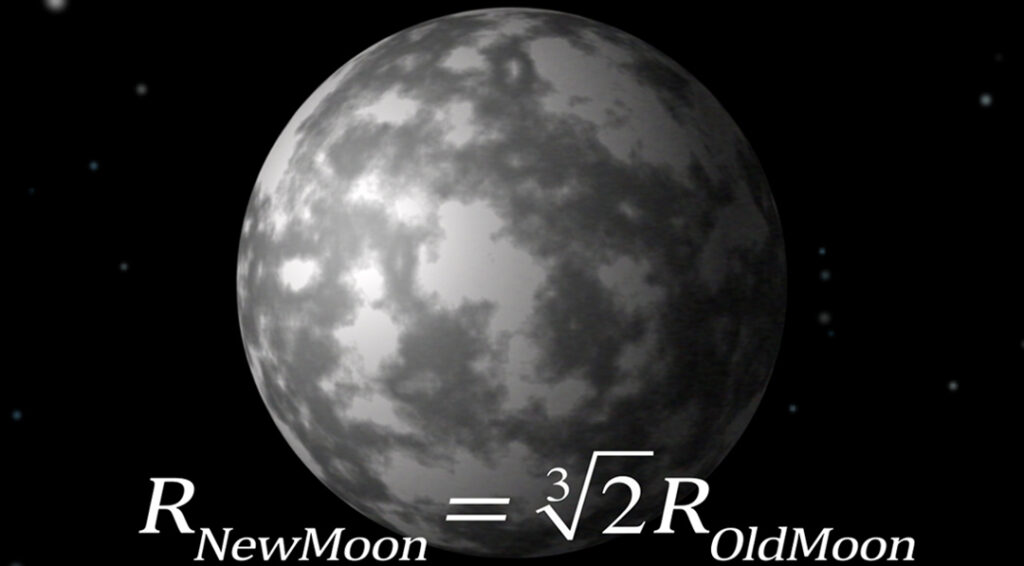
However, black holes work differently. For example if the Earth were to be compressed to the point where it would become a black hole, what would the radius of that black hole be?
Radius of Earth as a Black Hole
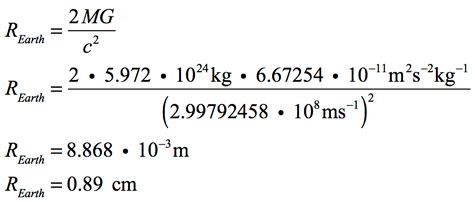
Radius of Sun as a Black Hole
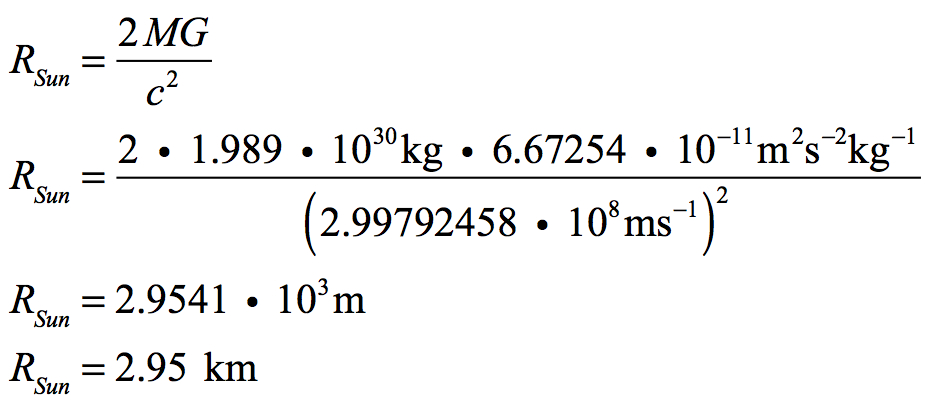
If the Schwarzschild dimensions for the Earth and the Sun are compared, it becomes apparent that the greater the mass, the less the critical density necessary to make a black hole.
It is interesting that the critical density to make the Sun a black hole is 9.02 • 10-12 less than that needed to make the Earth a black hole. This is the inverse square of their relative mass. As mass accumulates, the critical density rapidly declines.
| Mass | Black Hole Radius | Black Hole Volume 4/3 π R3 | Critical Density | |
| Earth | 5.97 • 1024 kg | 8.87 • 10-3 m | 2.92 • 10-6 m3 | 2.04 • 1030 kg m-3 |
| Sun | 1.99 • 1030 kg | 2.95 • 103 m | 1.08 • 1011 m3 | 1.84 • 1019 kg m-3 |
| Ratio Sun/Earth | 3.33 • 105 | 3.33 • 105 | 3.69 • 1016 | 9.02 • 10-12 |
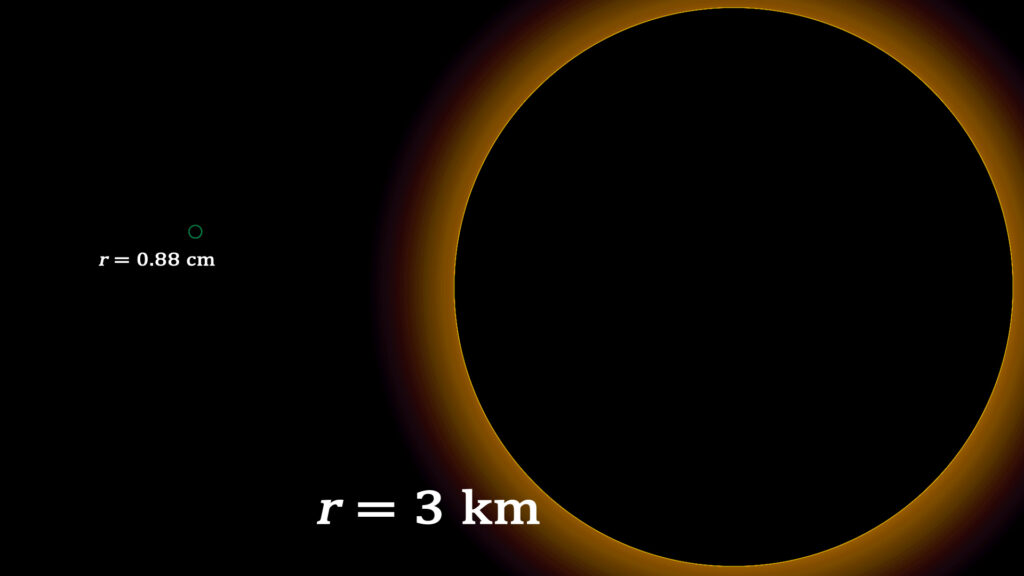
Universal Black Hole
The Schwarzschild formula defines the size of a black hole. The Universe began this incarnation at the Big Bang. It started at an incredible density. The mass density of the Universe in its early stage of expansion, throughout its life, and at the current moment meet Schwarzschild’s curvature requirement for a Universal Black Hole. If the Schwarzschild formula were to have been applied to the Universe at the Big Bang or any time after that event, it would show that the Universe is a black hole. Today is no exception.
This has been evident for many years, but the scientific community never accepted that possibility because the current paradigm of how black holes crush everything into a central singularity does not leave the Universal Black Hole model as a possibility. A simple adjustment to that model makes a black hole’s event horizon, rather than a singularity, the point of action. This is a change in the interpretation of General Relativity and not a change in the formulas. The question becomes, do the General Relativity formulations win out over the intuitive problems with the black hole model? Occam’s Razor sides with the Einstein – Schwarzschild’s formulations. Occam’s Razor takes General Relativity’s formulations literally. It does not finesse around infinities, zero and apparent violations of Special Relativity.2 The black hole model just has to be adjusted to the reality of General Relativity.
The Universe will be referred to interchangeably as the Universal Black Hole. Black holes are the simplest structure in the Universe. They remove much of the complexity of other astronomical objects. The Universal Black Hole defines the limit of spacetime. In this way it differs from other astronomical objects. It is the container of the Universe. Black holes don’t enclose matter as do other astronomical objects; they enclose spacetime.
The Universe curves around on itself. The completion of that curvature is the event horizon. Current theory seems to leave the Universe’s limits unidentified, yet it is generally understood that wherever one is this isotropic Universe will appear similar to the vantage point seen here on Earth. The black hole model clears up that vagary by describing the source of the Universe’s isotropy.
The Big Bang is this Universe’s central singularity. Since then that Universe has expanded until the present day. The surface of the Universal Black Hole is the event horizon. As its name indicates, it is this surface where all events are being created and thus represents the universal present for the Universe.
The Universe’s black hole structure unifies the physics of the Universe. As is seen in the Occam’s Razor theory, many of the universal formulas are radius-based. The Universal Black Hole model gives the Universe a common radius, a common present, and unified physical formulations.
The Mass of the Universal Black Hole
In chapter 1 the radius of the Universe was determined to be 1.305 • 1026 meters. If the Universe were to be a black hole, what would be the corresponding mass? The first thing that needs to be done is to adjust the black hole formula for an object within this Universe to one where the Universe is a black hole.3
With the previously calculated radius, calculating the mass of the Universal Black Hole is quite simple:

This results in the following calculation:
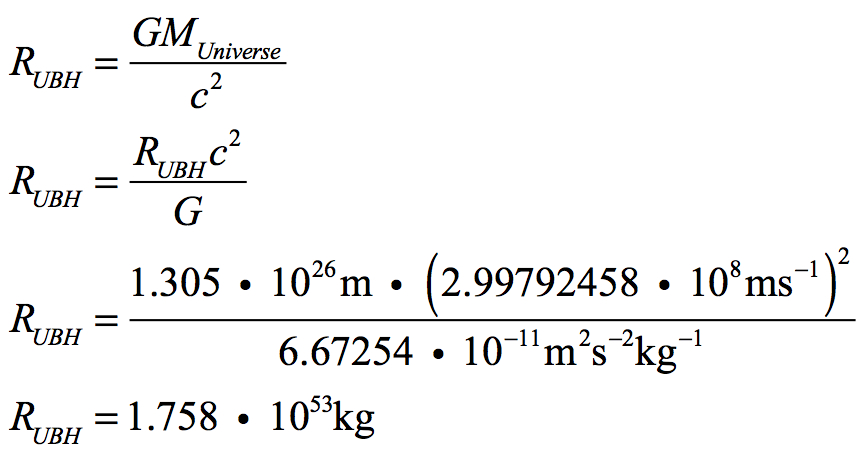
This mass should approximate that observed by astronomers. Current estimates of the Universe’s mass are between 1052 and 1054 kg. Many estimates are based on the observable Universe. Inflation-based and other theories posit that the observable Universe is believed to be a small fraction of the whole since the theoretical velocity of expansion during the pre-Big Bang period was far beyond the velocity of light.
Since current theories state that the Universe is far larger than what is considered observable, believers in these theories do not have accurate estimates of the greater Universe’s mass. Occam’s Razor has a radius that is equal to the distance that light can travel over the age of the Universe. Therefore, the observable Universe and that calculated here are the same.
The Density of the Universal Black Hole
Density is a calculation of the mass per unit of volume. The volume of a sphere is proportional to the cube of the radius of that sphere.

The radius of the Universal Black Hole is a linear relationship to the Universal Black Hole’s mass. As the mass of the Universe increases, the critical density of the Universe declines as an inverse square. While intuition makes one feel that it takes a great concentration of mass to create a black hole, if there is sufficient mass, any density can lead to the complete spacetime curvature of a black hole.
If the volume of the Universe were to be equal to R3,4 then the mass-density of the Universal Black Hole would be 7.902063 • 10-26 kg/m3:
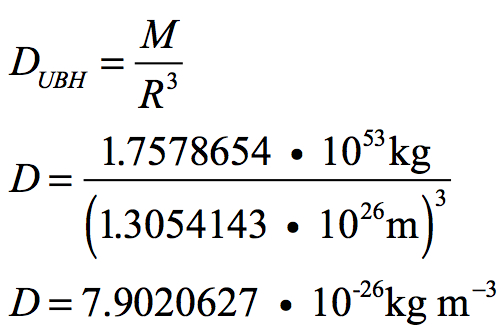
This is roughly equivalent to 47 protons for every cubic meter of space:5

This is extremely close to the observed mass-density of the Universe. Current estimates of visible matter is around 3 • 10-28 kg m-3. Since current estimates of “dark matter” approach 90% of the Universe’s mass, which is not directly measurable, then total mass density for the Universe approaches the 8 • 10-26 kg m-3 determined by this theory.
Escape Velocity
If a rocket leaves Earth’s atmosphere at a velocity approximating 25,000 mph, assuming no interference from other planets, it will continue to move away from Earth at a progressively slower pace. If the velocity is the exact escape velocity, it will continue moving away forever slowing at a velocity that approaches, but never reaches, zero. If traveling at the exact escape velocity, it will not have any excess velocity beyond the zero asymptote. The Earth’s gravitational hold on the rocket continues to weaken, but so does the spacecraft’s velocity.
For the Universe, the gravitation of all its mass acts as a central force pulling everything together. Over time the outward movement of the Universe slows and with it the velocity of light declines. The formula for escape from a gravitational force is
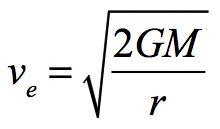
This is the formula for escape from a mass within the Universe. For the Universe the escape velocity is that of light and this formula becomes:
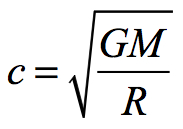
The Universe expands at the velocity of light. All mass resides in the present moment on the surface of the Universal Black Hole. The surface is the event horizon. The mandatory velocity for the event horizon is the velocity of light. So the expansion proceeds at c. As will be illustrated later, the mass of the Universe increases with the expansion. The increasing mass causes the radius of the Universal Black Hole to increase. Therefore, the vector of spacetime is towards an increasing event horizon. The collective mass of the Universe causes the escape velocity to decline. This results in a declining velocity of light. The universal formula above is the exact escape velocity. The Universe is at the perfect balance between having excess velocity and collapsing on itself. Therefore, the cosmos is perfectly flat.
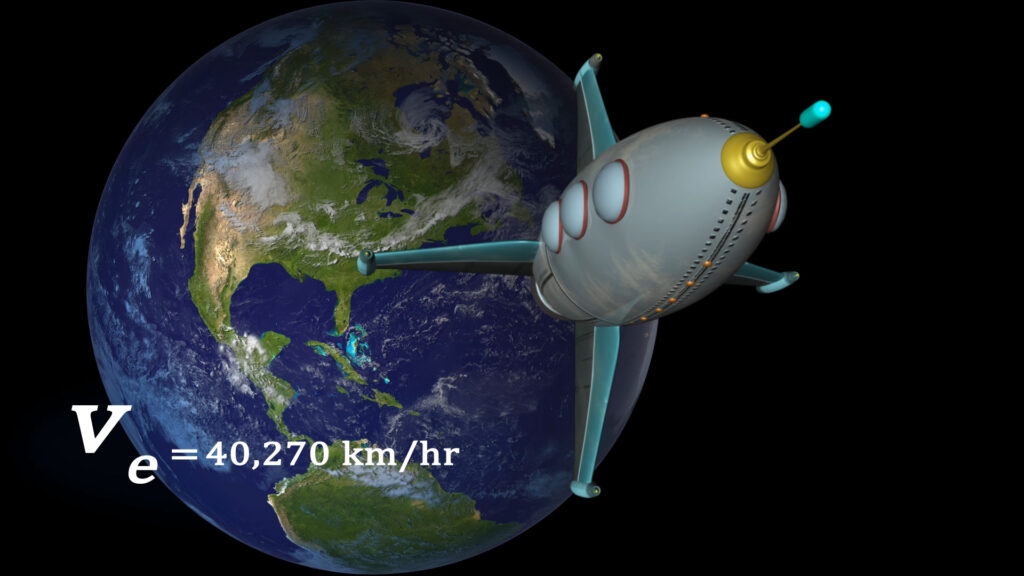
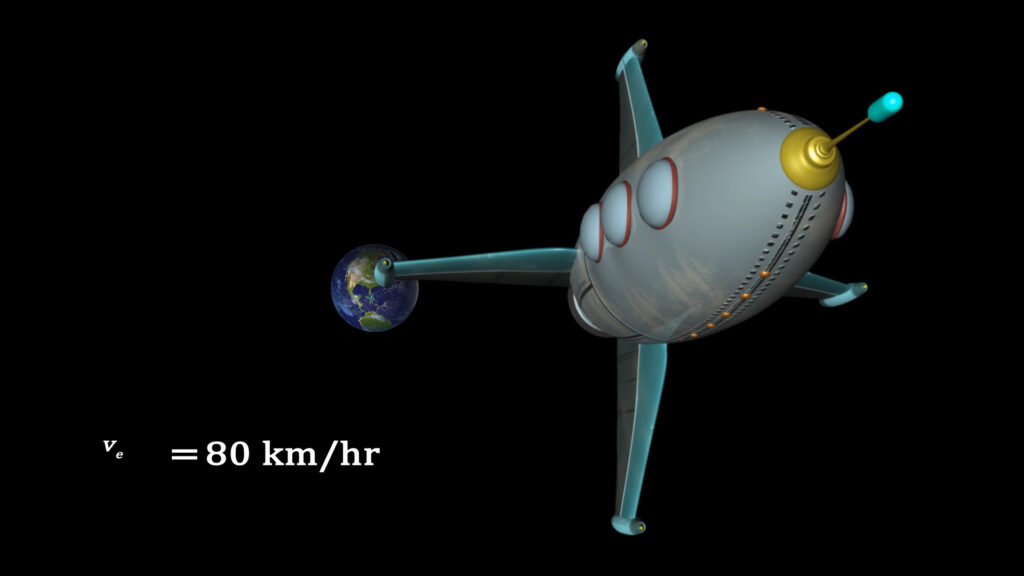

- Tons is a measurement of weight in a gravitational field. The reference here is referring to an Earth’s gravity mass equivalent. Mass, unlike weight, is an inertial measurement, but familiarity with Earth-based weight makes it an understandable reference.
- This is explored in Chapter 8 and in greater detail in a book Black Holes – The New Paradigm by Gary Lyon Otto.
- There is a reason for this adjustment. It has to do with observing the Universal Black Hole from within versus outside as would be the case of a black hole contained within our Universe.
- The volume of a sphere is of course 4/3 π r3 not r3, but since the Universe is observed by each mass’ surface location around which gravitational curvature has rolled the inside of the Universal Black Hole, the 4/3 π is divided by the reverse curvature of the observer making volume 4/3 π r3 / 4/3 π.
- A great portion of the Universe’s mass does not reside in baryonic matter so the proton equivalence is for comparison purposes only.
